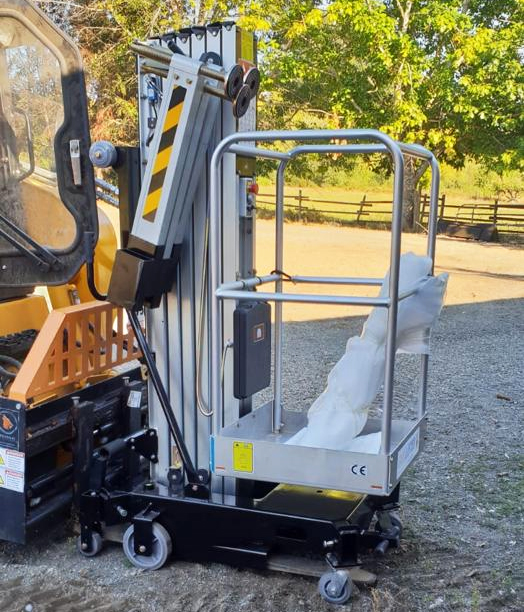Aluminum man lifts are widely used in the field of aerial work because of their lightweight and durable characteristics.
However, the chain, as its core transmission and load-bearing components, once it falls off, it will not only cause the equipment to be paralyzed, but also bring serious safety risks.Today we will analyze the cause of the chain falling off in depth, and provide clear troubleshooting and maintenance guidelines.
The four main reasons for the chain falling off
1. Daily wear and fatigue
In the long-term use of the chain, there will be constant friction between the pin shaft and the sleeve, resulting in the lengthening of the link (elongation).
When the length of the chain exceeds the allowable tolerance, its engagement with the sprocket will become mismatched, and it is prone to tooth skipping and shedding. This is the most common reason.
2. Improper installation and commissioning
* Uncomfortable tensioning: the chain is too loose to fit tightly with the sprocket, and it is easy to shake and fall off; if the chain is too tight, it will intensify wear and produce abnormal noise.
*The sprocket is not aligned: The active sprocket and the driven sprocket are not on the same plane, which will cause the chain to withstand lateral forces during operation and be “separated” from the track.
3. Operational and environmental factors
*Overload operation: The huge tension that exceeds the rated load may directly break the chain or deform it.
*External impact: During the movement or operation of the equipment, the chain part is collided, which may cause the link to deform or the pin shaft to loosen.
*Lack of lubrication: In humid climates, if the chain is not regularly lubricated, corrosion and wear will be accelerated, toughness will decrease, and brittleness will increase.
4. Deformation or damage to parts
Severe wear and tear of the sprocket teeth, deformation or loss of the chain guard (shield), and cracks or deformation of the links or joint plates of the chain itself will destroy the normal transmission relationship.
When encountering falling off, how to deal with it correctly and urgently?
Safety first!Please perform the following steps immediately:
1. Stop immediately: Press the emergency stop button, cut off the total power supply of the equipment, and hang a “No operation” warning sign.
2. Unloading pressure: Ensure that the lifting platform has been lowered to the lowest point or has been safely and firmly supported by rigid supports (such as support wood) to release all tension of the chain.
3. Preliminary inspection: Under the premise of ensuring safety, observe the shedding situation and check for obvious broken, deformed or damaged parts. Do not try to install with your bare hands or perform repairs in an unsafe state.
Three, professional maintenance steps
For non-professionals, it is strongly recommended to contact a local professional maintenance service. The following is the standard repair process for professionals:
1. Comprehensive inspection:
· Check whether all links are flexible, measure the elongation of the chain, and determine whether it needs to be replaced.
· Check the degree of wear and alignment of the two sprockets.
· Check whether the chain rail and shield are intact.
2. Replacement and adjustment:
·Replace the chain: If the chain wear exceeds the standard, the main and auxiliary chains must be replaced in pairs to ensure the same length and tension and avoid unilateral force.
* Adjust the tensioning degree: adjust the chain to the appropriate tightness through the tensioning bolts (usually the sagging amount in the middle part is about 2%-4% of the center distance between the two sprockets).
*Correction sprocket: Use tools such as laser centering instruments to ensure that the main and slave sprockets are fully aligned.
3. Testing and acceptance:
· After the installation is completed, jog and run without load to observe whether the engagement between the chain and the sprocket is smooth and whether there is any abnormal noise.
· Conduct a load test to confirm that the operation is stable and correct before it can be put into normal use.
Prevention is better than treatment: establish a regular maintenance system, including monthly inspections of chain wear and tension, quarterly lubrication, and annual professional and comprehensive inspections, which can effectively avoid the occurrence of such failures and ensure the safety of operations.
Post time: Sep-27-2025

